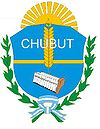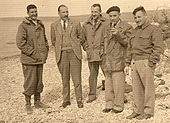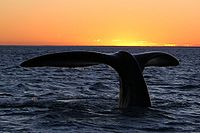- Chubut Province
-
Chubut
Provincia del Chubut— Province — 
Flag
Coat of armsMotto: "Ni muerte ni esclavitud. Solo patria y libertad" (Spanish)
"Neither death nor slavery. Only motherland and freedom"
"Nid yw marwolaeth na caethwasiaeth. Unig mamwlad a rhyddid"Location of Chubut within Argentina Country Argentina Capital Rawson Languages Spanish, Welsh Departments 15 Municipalities and communes 47 Government – Governor Mario Das Neves (PJ) – Legislature 27 – National Deputies
5– National Senators Marcelo Guinle, Graciela Di Perna, Mario Cimadevilla Area
Ranked 3rd– Total 224,686 km2 (86,751.7 sq mi) Population (2010[1]) – Total 506,668 (Ranked 18th) – Density 2.3/km2 (6/sq mi) Demonym chubutense Time zone ART (UTC−3) ISO 3166 code AR-U Website chubut.gov.ar Chubut (Spanish: Provincia del Chubut, IPA: [tʃuˈβut]; Welsh: Talaith Chubut) a province in the southern part of Argentina situated between the 42nd parallel south (forming the border with the Río Negro Province) and the 46th parallel south (bordering Santa Cruz Province), the Andes range separating Argentina from Chile, and the Atlantic ocean. The province's name derives from the Tehuelche word chupat, meaning "transparent," their description of the Chubut River.
The largest city, with 180,000 inhabitants, is Comodoro Rivadavia in the south of the province. The administrative capital is Rawson (40,000). Other important cities are Puerto Madryn, Trelew, Esquel and Sarmiento. Gaiman is a cultural and demographic centre of the region known as "Y Wladfa" in which Welsh-Argentines are concentrated. The 25,000 Welsh speakers in the Chubut region[2] are concentrated in the original Welsh settlements of Trelew and Trevelin.
Contents
History
 Argentine Geological Society founder Dr. Victorio Angelelli (2nd from right), ca. 1950, whose study of Chubut's mineral wealth helped breathe life into the province's economy.
Argentine Geological Society founder Dr. Victorio Angelelli (2nd from right), ca. 1950, whose study of Chubut's mineral wealth helped breathe life into the province's economy.
Before the Spaniards arrived in America, nomadic indigenous peoples inhabited the Patagonia region. In the 17th and 18th centuries, Spanish missionaries came to the area, and founded the San José Fort on Península Valdés, which was later destroyed by local native peoples. The region was disputed between Chile and Argentina until 1881, when Chile renounced its claim in order to keep Argentina out of the Pacific War. In 1865, Welsh people came to Chubut in the Mimosa ship and were settling in Chubut Valley area.
As part of the Conquista del Desierto (Desert conquest), the National Territory of Chubut was created in 1884, of which Luis Fontana was named governor. At the beginning of the 20th century, after the Boer War, some Boer people settled in the town of Sarmiento, and in lesser number in other nearby towns.
In 1944, the southern part of Chubut and northern part of Santa Cruz were designated the Comodoro Rivadavia military zone. The zone was dissolved in 1955, and Chubut was declared a province.
Population shifts of the 20th century, especially from Buenos Aires, raised the population steadily from 190,000 (1970), to 357,000 (1991) and 413,237 (2001). Most of the inhabitants are in the main cities, or in lesser numbers along the Chubut River, which gives most areas a population density of less than 1 inhabitant per square kilometer.
Economy
Chubut's economy, for a long time one of the most prosperous in Argentina, is one of the country's least diversified. Its 2006 output, estimated at US$4.7 billion,[3] is made up in almost a fourth by mining and petroleum. This sector's contribution (mostly centered around Comodoro Rivadavia) helped give Chubut the nation's fifth-highest per capita output in 2006, US$11,250 (a fourth higher than the national average).
Petroleum refining is the main economic activity of the province, with 13% of Argentine oil production (mostly off-shore). 21% of the nation's fish catch is produced by Chubut.
Sheep ranching, though less than half as productive than as recently as 1990, remains important at the local level. The advent of synthetic replacements to wool after World War II battered the sector, further decimated by Argentina's political instability and natural disasters. Wool production has risen since 2002, however, and totaled 71,000 tons in 2006.[4]
Geography and Climate
Chubut stretches from the Atlantic to the Andes: the coast is marked by high cliffs and sandy beaches, whereas the centre consists of several plateaus and depressions. The Andes are not very high in Chubut, with most peaks between 1,500 m and 2,000 m.
The coast is exceptionally mild for Patagonia due to warm currents from Brazil: daytime highs range from 24ºC (75F) to 28ºC (83F) and night temperatures range from 11ºC (52F) to 15ºC (59F) during the summer. Falls are pleasant with cool nights, and winters are moderate, with days ranging from about 9ºC (48F) in the south to 13ºC (55F) in the north, and nights from 1ºC (34F) to 4ºC (40F). Precipitation is low, from 150 mm to 250 mm. Temperatures below -10ºC (14F) are infrequent, as is heavy snow.
The plateaus are considerably more extreme weatherwise. Temperatures are warm during summer days, with the same range as in the coast, and cooler nights below 10ºC (50F). However, as fall approaches, night frost becomes the rule, and winters can sometimes be quite severe. Depending on elevation, daytime highs range from 3ºC (37F) to 9ºC (48F), while nighttime lows go from -1ºC (30F) to as low as -6ºC (21F). The lowest temperatures go from -25ºC to -30ºC (-13F to -22F) with severe wind chill. Snow is common, but in low quantities due to aridity.
The west becomes wetter as we approach the Andes, and some spots attain 4,000 mm of rainfall. Summers are cool and windy, at 20ºC to 22ºC (68F to 74F) during the day and 5ºC to 7ºC (41F to 45F) at night. Winters are very stormy, with rain, sleet and snow, highs from 4ºC to 8ºC (39F to 47F) at low altitudes, and lows from 0ºC (32F) to -4ºC (25F). Temperatures rarely dip below -20ºC (-4F) but heavy snow may occur.
Altitudes over 1,000 m have constant winter snow cover, and over 2,000 m, the snow remains until midsummer. Higher peaks are heavily glaciated.
Media
Newspapers
There are a number of print newspapers including:
- Crónica and El Patagónico in Comodoro Rivadavia
- El Oeste in Esquel
- El Diario de Madryn in Puerto Madryn
- El Chubut and Jornada in Trelew
Y Drafod, Welsh Language Newspaper since 1891 Clecs Camwy, new Welsh monthly 2011
Online journalism
Online journalism has a small, growing presence in Chubut. The six print newspapers have online editions; but these are only updated every 24 hours. Some new digital proposals make a better use of web's potential. One case is Infochubut.com, a recent publication that works with audio, video, text and photographs for its news and offers forums for public participation. Some radio stations in northwest Chubut began to publish online some of the interviews they make in there radio studies.
Radio
The most populous cities are served by AM radio stations like Chubut Radio and Three Radio in Trelew, Golfo Nuevo's Radio in Puerto Madryn, National Radio in Comodoro, Rivadavia and Esquel. There are also several FM radio stations which broadcast programs from a national central office.
Television
The provincial government runs a TV network that covers the province. In Trelew, Comodoro Rivadavia, Esquel, Puerto Madryn and in some small towns there are other local TV stations producing local programming to supplement the programming received from the Buenos Aires networks.
Tourism
 Southern right whale in Península Valdés, its preferred sanctuary.
Southern right whale in Península Valdés, its preferred sanctuary. See also: Tourism in Argentina
See also: Tourism in ArgentinaTourism is also a growing industry. The main attractions are Peninsula Valdés and other marine wildlife reservoirs such as Punta Tombo and Punta Ninfas, with right whales, eared seals, elephant seals, penguins, orcas and many other animals. At the Punta Tombo site there is one of the largest breeding areas for the Magellanic penguin.[5]
Further south, on the sparsely populated beaches of the Golfo San Jorge, is the only place in the world where the peculiar, flightless Chubut Steamer Duck can be observed. In the Andean region, the Los Alerces National Park, impressive lakes and hikes near Esquel are also visited every year by many tourists. The 'Old Patagonian Express' (also known as La Trochita), the old steam train made famous by Paul Theroux, attracts many to Esquel, as does the La Hoya ski center. The petrified forest near Sarmiento is a 150 km² park with some of the largest fossilised trees in the world.
Transport
The Ruta Nacional 3 runs along the coast line up to Buenos Aires, and down to Tierra del Fuego. The Ruta Nacional 25 crosses Chubut from East to West, connecting Trelew and Esquel, but half of it has not yet been paved. Regular long distance buses run several times a day to Buenos Aires, and to many locations in the Santa Cruz Province. Short range buses to towns in Chubut run at least once a day. There are also daily summer buses on the route #25. The Trelew airport (IATA REL) serves regular flights to/from Buenos Aires and El Calafate. Airports are also maintained at Comodoro Rivadavia, Rawson and Esquel.
Major highways include:
- Route 2, from Puerto Pirámides and Península Valdés
- Route 3, north-south via Trelew and Comodoro Rivadavia
- Route 26, west from Comodoro Rivadavia (223 km)
- Route 20, which continues north 178 km to Jose de San Martín
- Route 22, north from Perito Moreno (Santa Cruz province) 125 km
- Route 25, west from Trelew (341 km)
- Route 62, which continues west 166 km to join Route 40 at Tecka
- Route 40, traveling north 266 km via Esquel to Cabeza del Indio
- Route 30, east 73 km from Route 3 to the coast at Camarones
- Route 259, west from Esquel to Chile.
Four other roads travel west to Chile's Aysén region, including Balmaceda and Coihaique Alto, and two to Chile's Los Lagos region from Corcovado to Palena and from Esquel via Trevelin to Futaleufu.
Political divisions
The province is divided into 15 departments (Spanish: departamentos).
Department (Capital)
- Cushamen Department (Cushamen)
- Escalante Department (Comodoro Rivadavia)
- Florentino Ameghino Department (Camarones)
- Futaleufú Department (Esquel)
- Gaiman Department (Gaiman)
- Gastre Department (Gastre)
- Languiñeo Department (Tecka)
- Mártires Department (Las Plumas)
- Paso de Indios Department (Paso de Indios)
- Rawson Department (Rawson)
- Río Senguer Department (Alto Río Senguer)
- Sarmiento Department (Sarmiento)
- Tehuelches Department (José de San Martín)
- Telsen Department (Telsen)
- Biedma Department (Puerto Madryn)
Institutions
Chubut is covered by the Roman Catholic Diocese of Comodoro Rivadavia. The Cathedral, dedicated to San Juan Bosco is in Comodoro Rivadavia and the Bishop since 2005 is Virginio Domingo Bressanelli. Other faiths are active in Chubut, principally amongst the Welsh chapels as well as Lutheran and Muslim places of worship in Comodoro.
The university—Universidad Nacional de la Patagonia San Juan Bosco—is based in Comodoro Rivadavia with campuses at Esquel, Trelew and Puerto Madryn, as well as in Ushuaia, Tierra del Fuego.
References
- ^ Censo 2010 Argentina resultados provisionales: mapas
- ^ "Languages of Argentina" - Ethnologue.com
- ^ IADER: Nueva Etapa (2008)
- ^ MECON Republica Argentina (2008)
- ^ C. Michael Hogan (2008) Magellanic Penguin, GlobalTwitcher.com, ed. N. Stromberg
External links
- Infochubut - Online journalism (Spanish)
- Chubut's Official Page (Spanish)
- Chubut Province in Argentour
- Links to newspapers and radios from Chubut (Spanish)
- Puerto Pirámides' official website (Spanish)
- Minerals of Chubut (Spanish)
Provinces of Argentina Provinces Buenos Aires · Catamarca · Chaco · Chubut · Córdoba · Corrientes · Entre Ríos · Formosa · Jujuy · La Pampa · La Rioja · Mendoza · Misiones · Neuquén · Río Negro · Salta · San Juan · San Luis · Santa Cruz · Santa Fe · Santiago del Estero · Tierra del Fuego · Tucumán

Autonomous city Categories:- Provinces of Argentina
- Chubut Province
- States and territories established in 1955
Wikimedia Foundation. 2010.



